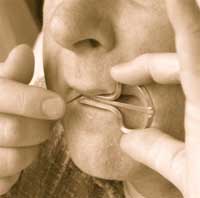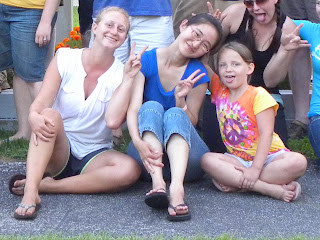
We’ve been busy with Fort St. Joseph-related activities since completing our fieldwork last August. As the semester winds down I thought I’d take the time to provide an update on what I’ve been doing and what we’ve accomplished over the past year. Of course, this is in addition to everything my students who are working on the projects have been writing about in their regular blogs.
(Picture Caption) Participants in the panel discussion at the conference of the Center for French Colonial Studies in Columbia, Illinois (l-r): Michael Nassaney,Suzanne Corbett, Jesse Laurentius, Robert Englebert, and Hans Baade.
In September I attended the annual conference of the Center for French Colonial Studies held in Columbia, IL where I moderated a panel focused on the women of New France. This was a very familiar topic, since it was the theme of our 2010 field season that culminated in our first publication in the popular booklet series. The conference was an opportunity to reconnect with other French colonial aficionados and meet some new ones. A new contact, David MacDonald (Illinois state University) has assisted us by correcting our initial misreading of the lead seal that we recently recovered from the fort. More will be published on this in Le Journal, the quarterly publication of the Center.
I was invited to a symposium in November at Purdue University for the Battle of Tippecanoe bicentennial commemoration. My presentation to a full house discussed the relationships between the French and Natives peoples in the eighteenth century fur trade from the perspective of the western Great Lakes and Fort St. Joseph to provide historical background for understanding later relations with the English and the Americans. The symposium was unique because it brought together historians, park managers, preservationists, archaeologists, and Native peoples descended from the many tribes who were present at the battle to discuss ways to interpret the site that take into account the horrific events than transpired in the American quest for manifest destiny. Many of us left the symposium with a new resolve to create a more inclusive history.
It’s that time of the year when I typically compile an annual report that summarizes all of our activities through the end of the field season. Once again, we have remained extremely busy and we have lots to show for it! The annual report will be posted to the web site in the next few weeks and will contain a complete listing of project outcomes. In the meantime, here are some of the highlights, some of which might be old news to those of you who keep a close watch on our activities:
· The project was the winner of the prestigious Archaeological Institute of America’s first Education Outreach Contest
· The third annual summer lecture series was devoted to the theme of the open house which focused on “The Archaeology and History of the Fur Trade”
· A grant of $10,175 was received from the Michigan Humanities Council to support our annual open house
· Students and staff were recruited from distant states, including Maryland, Massachusetts, and Missouri, testifying to the national visibility of the project
· Mayor McCauslin, Provost Greene, and Dean Enyedi visited the site during our annual media day
· The first Volunteer of the Year for service to the project was recognized.
· Summer camps were overenrolled with 35 students, teachers, and life-long learners participating over three weeks.
· The second annual issue of the Fort St. Joseph Post newsletter was distributed.
· We were awarded a grant for $9,605 from Digital Antiquity to upload, store, and make accessible digital documents associated with Fort St. Joseph
· We identified another stone fireplace in our excavation, likely representing a fourth domestic structure
· The open house again attracted nearly two thousand visitors, bringing the total number to over ten thousand since the event began in 2006.
· Over 50 volunteers contributed hundreds of hours promoting the goals of the Fort St. Joseph Archaeological Project
In addition, we have begun serious discussions regarding a permanent building in Niles to facilitate the archaeological investigation and interpretation of Fort St. Joseph. We have also been meeting with area museums to plan a major exhibit that tells the story of Fort St. Joseph and what archaeology is teaching us about life in the eighteenth century. Finally, we are busy working on the second issue of our booklet series devoted to the North American fur trade. Written by Rachel Juen and me, with help from lots of other contributors, the booklet will meet the high standards we set in compiling the Women of New France by providing authoritative information and numerous high quality color images to convey the complexity and significance of the fur trade to a wide audience. Stay tuned to learn more about each of these new initiatives and let us know how you would like to be involved.
Michael Nassaney, Ph.D.
Professor of Anthropology
Principal Investigator
Fort St. Joseph Archaeological Project




























